A Novel Prognostic Risk Model for Cervical Cancer Based on Immune Checkpoint HLA-G-Driven Differentially Expressed Genes
- PMID: 35924232
- PMCID: PMC9341272
- DOI: 10.3389/fimmu.2022.851622
A Novel Prognostic Risk Model for Cervical Cancer Based on Immune Checkpoint HLA-G-Driven Differentially Expressed Genes
Abstract
Human leukocyte antigen G (HLA-G) is a potential checkpoint molecule that plays a key role in cervical carcinogenesis. The purpose of this study was to construct and validate a prognostic risk model to predict the overall survival (OS) of cervical cancer patients, providing a reference for individualized clinical treatment that may lead to better clinical outcomes. HLA-G-driven differentially expressed genes (DEGs) were obtained from two cervical carcinoma cell lines, namely, SiHa and HeLa, with stable overexpression of HLA-G by RNA sequencing (RNA-seq). The biological functions of these HLA-G-driven DEGs were analysed by GO enrichment and KEGG pathway using the "clusterProfiler" package. The protein-protein interactions (PPIs) were assessed using the STRING database. The prognostic relevance of each DEG was evaluated by univariate Cox regression using the TCGA-CESC dataset. After the TCGA-CESC cohort was randomly divided into training set and testing set, and a prognostic risk model was constructed by LASSO and stepwise multivariate Cox regression analysis in training set and validated in testing set or in different types of cervical cancer set. The predictive ability of the prognostic risk model or nomogram was evaluated by a series of bioinformatics methods. A total of 1108 candidate HLA-G-driven DEGs, including 391 upregulated and 717 downregulated genes, were obtained and were enriched mostly in the ErbB pathway, steroid biosynthesis, and MAPK pathway. Then, an HLA-G-driven DEG signature consisting of the eight most important prognostic genes CD46, LGALS9, PGM1, SPRY4, CACNB3, PLIN2, MSMO1, and DAGLB was identified as a key predictor of cervical cancer. Multivariate Cox regression analysis showed that this signature is an independent risk factor for the overall survival of CESC patients. Kaplan-Meier survival analysis showed that the 5-year overall survival rate is 23.0% and 84.6% for the high-risk and low-risk patients, respectively (P<0.001). The receiver operating characteristic (ROC) curve of this prognostic model with an area under the curve (AUC) was 0.896 for 5 years, which was better than that of other clinical traits. This prognostic risk model was also successfully validated in different subtypes of cervical cancer, including the keratinizing squamous cell carcinoma, non-keratinizing squamous cell carcinoma, squamous cell neoplasms, non-squamous cell neoplasms set. Single-sample gene set enrichment (ssGSEA) algorithm and Tumor Immune Dysfunction and Exclusion (TIDE) analysis confirmed that this signature influence tumour microenvironment and immune checkpoint blockade. A nomogram that integrated risk score, age, clinical stage, histological grade, and pathological type was then built to predict the overall survival of CESC patients and evaluated by calibration curves, AUC, concordance index (C-index) and decision curve analysis (DCA). To summarize, we developed and validated a novel prognostic risk model for cervical cancer based on HLA-G-driven DEGs, and the prognostic signature showed great ability in predicting the overall survival of patients with cervical cancer.
Keywords: HLA-G; cervical cancer; immune checkpoint; mRNA signature; prediction; prognosis.
Copyright © 2022 Xu, Wang, Xing and Wang.
Conflict of interest statement
The authors declare that the research was conducted in the absence of any commercial or financial relationships that could be construed as a potential conflict of interest.
Figures
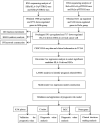
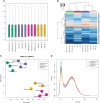
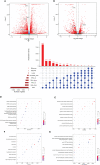


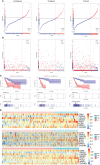



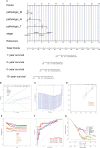
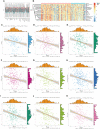


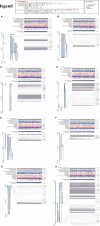
Similar articles
-
Construction of a novel mRNA-signature prediction model for prognosis of bladder cancer based on a statistical analysis.BMC Cancer. 2021 Jul 27;21(1):858. doi: 10.1186/s12885-021-08611-z. BMC Cancer. 2021. PMID: 34315402 Free PMC article.
-
Construction of mRNA prognosis signature associated with differentially expressed genes in early stage of stomach adenocarcinomas based on TCGA and GEO datasets.Eur J Med Res. 2022 Oct 17;27(1):205. doi: 10.1186/s40001-022-00827-4. Eur J Med Res. 2022. PMID: 36253873 Free PMC article.
-
Identification of a necroptosis-related prognostic gene signature associated with tumor immune microenvironment in cervical carcinoma and experimental verification.World J Surg Oncol. 2022 Oct 17;20(1):342. doi: 10.1186/s12957-022-02802-z. World J Surg Oncol. 2022. PMID: 36253777 Free PMC article.
-
Phosphorus Metabolism-Related Genes Serve as Novel Biomarkers for Predicting Prognosis in Bladder Cancer: A Bioinformatics Analysis.Iran J Public Health. 2024 Sep;53(9):1935-1950. doi: 10.18502/ijph.v53i9.16449. Iran J Public Health. 2024. PMID: 39429662 Free PMC article. Review.
-
Human leukocyte antigen-G in gynaecological tumours.Int J Immunogenet. 2023 Aug;50(4):163-176. doi: 10.1111/iji.12626. Epub 2023 Jul 6. Int J Immunogenet. 2023. PMID: 37415092 Review.
Cited by
-
miR-584-5p Regulates MSMO1 to Modulate the AKT/PI3K Pathway and Inhibit Breast Cancer Progression.Protein Pept Lett. 2025;32(3):171-182. doi: 10.2174/0109298665339026250114070523. Protein Pept Lett. 2025. PMID: 39950465
-
Immunosuppression by Inflammation-Stimulated Amplification of Myeloid-Derived Suppressor Cells and Changes in Expression of Immune Checkpoint HHLA2 in Chronic Obstructive Pulmonary Disease.Int J Chron Obstruct Pulmon Dis. 2023 Feb 18;18:139-153. doi: 10.2147/COPD.S394327. eCollection 2023. Int J Chron Obstruct Pulmon Dis. 2023. PMID: 36846109 Free PMC article.
-
Identification of a tissue resident memory CD8 T cell-related risk score signature for colorectal cancer, the association with TME landscapes and therapeutic responses.Front Genet. 2023 Jan 4;13:1088230. doi: 10.3389/fgene.2022.1088230. eCollection 2022. Front Genet. 2023. PMID: 36685946 Free PMC article.
-
Prognostic assessment of cervical cancer based on biomarkers: the interaction of ERRα and immune microenvironment.Virol J. 2025 Feb 24;22(1):47. doi: 10.1186/s12985-025-02664-3. Virol J. 2025. PMID: 39994715 Free PMC article.
-
A panel of seven immune-related genes can serve as a good predictive biomarker for cervical squamous cell carcinoma.Front Genet. 2022 Nov 2;13:1024508. doi: 10.3389/fgene.2022.1024508. eCollection 2022. Front Genet. 2022. PMID: 36406134 Free PMC article.
References
-
- WHO . Cervical Cancer . World Health Organization. Available at: https://www.who.int/news-room/fact-sheets/detail/human-papillomavirus-(h... (Accessed September 21, 2020).
Publication types
MeSH terms
Substances
LinkOut - more resources
Full Text Sources
Medical
Research Materials
Miscellaneous

